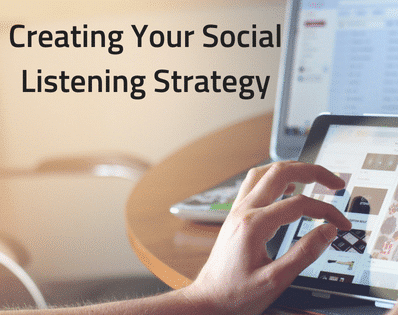An incredibly important part of your overall brand strategy is learning to use social listening. We’ve discussed what social listening is previously, but now it’s time to dig into how exactly to build a strategy that will allow you to really listen to your audience and grow your brand based on their feedback. Here are some things that you can do to start developing your social listening strategy and build long-term success for your brand.
Step 1: Set a baseline
Because social listening requires you to gather and analyze data, it’s a good idea to sit down and map out what exactly you’ll be looking for and monitoring. Make a list of keywords, hashtags, and catchphrases that are relevant in your industry. This will make it easier when you go to set up your monitoring tools and keep track of mentions on different platforms. It’ll help guide your search and make sure that the data you’re gathering is useful and relevant. The Twitter Business account gives some good basic advice on how to get started here. Additionally, you’ll want to have answers to the following questions:
- Who are the top influencers in my field?
- Do I currently have any followers who are true fans and frequently engage with my product?
- Who are my top competitors?
- What key phrases are often associated with my product and industry?
- Are there any hashtags already in use that are associated with my industry?
Don’t be afraid to watch and learn from competitors’ websites or social media accounts. They may give you insights on angles, topics, and keywords that your audience is connecting with you had hadn’t considered. Having answers to the above questions will give you a solid starting point to begin setting up the gathering data portion of social listening.
Step 2: Find the conversations
A key part of social listening is figuring out where your audience is talking about your product or industry. There are many different platforms and not all of them cater to the same conversations. It’s important before you launch any kind of social media campaign to find out exactly where your audience is and what they’re talking about. This means you’ll need to either hire a company to run searches for keywords and phrases on several different platforms, or learn to do so yourself manually. Even if some of your audience is on multiple platforms, their conversations are likely different on Facebook than they are on Twitter or Instagram. Find out where your audience is and what they’re talking about and use that as a general direction on where to focus your efforts. The platform and types of conversations your audience uses will dictate the kind of content you’ll produce and what kinds of interactions you’ll have with them.
Step 3: Engage, Learn, and Adjust
Once you’ve found your audience, it’s time to engage with them. A great way to learn about your audience is to interact with them. Make sure you’re responding to comments, commenting on other posts, and engaging in other activity in the communities that are relevant to you.
You’ll get the best results if your interactions are genuine and organic. If you’re joining another conversation, don’t derail a conversation with a sales pitch. Only engage if you have something beneficial to offer. Think long-term: you’re establishing your brand as a leader and a good resource in your field. Audiences are less likely to engage with you if they don’t trust you or think you’re only engaging to push them to purchase a product. It’s also a good idea to prepare responses to the different kinds of feedback you’ll get. Think ahead of time about how you’ll respond to negative, neutral, or positive feedback on different platforms and be prepared at least with an outline of a response.
A response on Twitter won’t be the same as a response on Facebook or Instagram. Make sure you’ve prepared for increased interaction with your audience. There’s no need to sound canned or rehearsed, but if you know ahead of time how you’ll respond to a disgruntled customer or know where to point an enthusiastic fan who wants to share your product, you’ll look far more polished and you’ll have better overall reactions. Set a time to analyze what you’ve learned since engaging in your social media strategy. Gather your results and notice overall feedback you’ve received. It’s also a good idea to pull the posts that saw the most and least interaction and analyze them in particular.
What worked, what didn’t? Does your audience love participating in polls but aren’t viewing your videos very often? Did a certain hashtag take off? Use these insights to adjust and fine-tune your future posts and content. When you’re in your analyzing phase, it’s also a good idea to look at not just the content your brand produced, but also the general mood of the industry at large. Notice any new trends that are starting to take off in your field that might help you engage with your audience more. Are there industry-wide weakness that you could help strengthen?
Looking at the big picture of your niche will help you focus your listening and will guide your broader strategy. Weaving all of these factors together gives you your social media strategy. Social listening is about learning from your environment and using that information to find your place in your community. Your brand doesn’t exist in a vacuum. This social listening strategy will help guide you as you find your place in your niche and build your brand.















